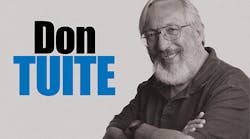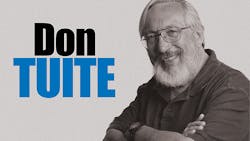Looking at the calendar, I see that according to today's date, I am . . . just about . . . RETIRED! I am almost 71-and-a-half, and feeling the deadline stresses a little too often to be as comfortable as I used to be.
Before I take off for new adventures, I wanted to say something about the state of technical communications to you readers, the audience that has constituted the other end of my communications channel over the years that I have written technical articles as a ghostwriter, and for the last 11 years as an editor here at Electronic Design. You are important to me, because, without you, I would be just a noise source.
I’ve always liked the communications-channel metaphor for what we do as editors in the technical media—in part because the metaphor is so flexible.
Back in 1948, Bell Lab’s Claude Shannon published A Mathematical Theory of Communication. That was steeped in mathematics, but Shannon was a creative enough thinker to go beyond the equations that related noise, data, and entropy when sending bits over a wire, He asked newspaper writer Warren Weaver to expand the concept and look at channels in all sorts of communications.
That paid off a decade later when media analyst Marshall McLuhan and graphic designer Quentin Fiore became sudden celebrities with the publication of The Medium is the Massage: An Inventory of Effects. McLuhan was already using the phrase “The medium is the message” to imply that the concept Shannon considered a channel could be extended to any mechanism for extending one person’s idea to another, and that mechanism was related in a symbiotic way to how the message is perceived.
That’s where I’m coming from when I speak of myself as a potential noise source: When I write an article for Electronic Design, I am a transmitter; you, the reader, are my receiver; and Electronic Design is the channel. All of that is subject to noise, which in turn introduces entropy (Shannon), and which by its very nature, influences the receiver’s perception of what is communicated (McLuhan).
But something interesting has been happening to the channel. While some of you are reading this in ink on paper, many more are reading it online.
The easy way to look at this is to say: “Well, yeah. Papyrus killed clay tablets, vellum killed papyrus, scribe-pens on paper killed vellum, the printing press put the scribes out of business, and, lo and behold, digital data has killed the codex (an old word for any book-shaped thingy), and it’s killing the printed magazine as a communications channel.”
I am told (and I believe) that that’s not going to happen to the print edition of Electronic Design any time soon, but somebody has to pay to advertise in a medium, and interesting things are happening there. In this case, “somebody” means a company that makes a physical product—a passive component, a semiconductor device, a test instrument—or some kind of intellectual property like a design tool.
That somebody needs to reach new customers, and guess what . . . the younger ones are not conditioned to think of ink-on-paper as a communications channel. It’s not just that they’re familiar with digital media, they have faith in it as a reliable, low-noise communications channel, with deep, archival capacities for the maintenance of old information. The Cloud is unfathomably deep, right?
Moreover, if a company has a web server, it doesn’t need anything else to reach customers. It controls the channel.
“Yeah, but,” some would say, “there are drawbacks.” I could speculate about what kinds of events would limit or eliminate access to cloud-maintained data, but any other storage mechanism has similar Achilles heels. (You’ve heard about Achilles, right? Okay, that’s because the Iliad was preserved via oral tradition, but it takes a special encoding methodology, called poetry, to minimize the effects of noise in the oral transmission channel.) Alternatively, you can try multiple redundant copies in widely dispersed places, but since you do not have a means to deal with entropy, errors will inevitably evolve.
For shorter periods of time, though, say the lifetime of some kind of electronic product, the Web backed up by the Cloud becomes an attractive channel.
But in the end, the channel is irrelevant without a transmitter (me) and a receiver to direct its content to (that’s you), and nothing I write has any meaning unless it reaches you and reduces your personal entropy on the topic I’m writing about. So, thank you for helping me communicate over all of these years.

